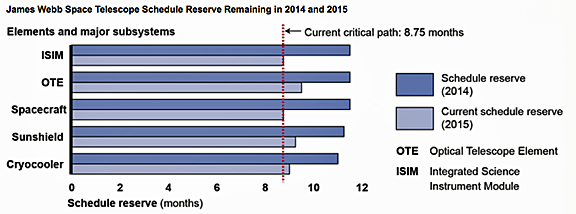[Satnews] The National Aeronautics and Space Administration's (NASA) James Webb Space Telescope (JWST) project is meeting its schedule commitments, but it will soon face some of its most challenging integration and testing.
JWST currently has almost nine months of schedule reserve—down more than two months since GAO's last report in December 2014—but still above its schedule plan and the Goddard Space Flight Center requirement. However, as GAO also found in December 2014, all JWST elements and major subsystems continue to remain within weeks of becoming the critical path—the schedule with the least amount of schedule reserve—for the overall project. Given their proximity to the critical path, the use of additional reserve on any element or major subsystem may reduce the overall project schedule reserve.

Source: GAO analysis of NASA data. | GAO-16-112
Before the planned launch in October 2018, the project must complete five major integration and test events, three of which have not yet begun. Integration and testing is when problems are often identified and schedules tend to slip. At the same time, the project must also address over 100 technical risks and ensure that potential areas for mission failure are fully tested and understood.
JWST continues to meet its cost commitments, but unreliable contractor performance data may pose a risk to project management. To help manage the project and account for new risks, project officials conducted a cost risk analysis of the prime contract. A cost risk analysis uses information about cost drivers, technical issues, and schedule to determine the reliability of a program's cost estimates. GAO found that while NASA's cost risk analysis substantially met best practices for cost estimating, officials do not plan to periodically update it. Instead, the project is using a risk-adjusted analysis to update and inform its cost position, but this analysis is a simplified version of a cost risk analysis—and not a replacement—and is based on contractor-provided performance data that contains anomalies that render the data unreliable. Further, the project does not have an independent surveillance mechanism, such as the Defense Contract Management Agency, to help ensure data anomalies are corrected by the contractor before being incorporated into larger cost analyses, as GAO recommended in 2012. As a result, the project is relying partially on unreliable information to inform its decision making and overall cost status.
JWST is one of NASA's most complex and expensive projects, at an anticipated cost of $8.8 billion. With significant integration and testing scheduled in the 3 remaining years until the planned launch date, the JWST project will need to continue to address many challenges and identify problems, many likely to be revealed during its rigorous testing to come. The continued success of JWST hinges on NASA's ability to anticipate, identify, and respond to these challenges in a timely and cost-effective manner to meet its commitments.
Conference Report 112-284 included a provision for GAO to assess the project annually and report on its progress. This is the fourth such report. This report assesses (1) the extent to which JWST is meeting its schedule commitments and (2) the current cost status of the project, among other issues. To conduct this work, GAO reviewed monthly JWST reports, reviewed relevant policies, conducted independent analysis of NASA and contractor data, and interviewed NASA and contractor officials.
GAO recommends that the JWST project require contractors to identify, explain, and document anomalies in contractor-delivered monthly earned value management reports. GAO continues to believe that its 2012 recommendation to implement formal surveillance to help improve the reliability of contractor-provided data has merit and should be implemented. NASA concurred with the recommendation made in this report.


